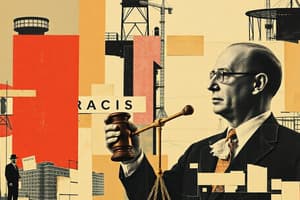Podcast
Questions and Answers
Workplace safety regulations aim to protect employees from hazardous conditions or practices in the workplace.
Workplace safety regulations aim to protect employees from hazardous conditions or practices in the workplace.
True (A)
An employment contract outlines the terms and conditions of the work relationship between an employer and employee.
An employment contract outlines the terms and conditions of the work relationship between an employer and employee.
True (A)
In at-will employment states, employers cannot terminate employment contracts without cause or notice.
In at-will employment states, employers cannot terminate employment contracts without cause or notice.
False (B)
Discrimination laws are not a part of industrial law.
Discrimination laws are not a part of industrial law.
Collective bargaining is a process where employers and unions negotiate terms and conditions of employment.
Collective bargaining is a process where employers and unions negotiate terms and conditions of employment.
The Occupational Safety and Health Administration (OSHA) requires employers to provide safe working environments for their employees.
The Occupational Safety and Health Administration (OSHA) requires employers to provide safe working environments for their employees.
Discrimination laws prohibit employers from treating applicants or employees unfairly based on characteristics like race, color, national origin, and age.
Discrimination laws prohibit employers from treating applicants or employees unfairly based on characteristics like race, color, national origin, and age.
Sexual harassment is not considered a form of discrimination under employment laws.
Sexual harassment is not considered a form of discrimination under employment laws.
Labor disputes can arise due to issues related to wages, hours, or working conditions.
Labor disputes can arise due to issues related to wages, hours, or working conditions.
Collective bargaining is the process by which a union and an employer negotiate the terms of a collective agreement that governs their relationship for a period of $10$ years.
Collective bargaining is the process by which a union and an employer negotiate the terms of a collective agreement that governs their relationship for a period of $10$ years.
Flashcards are hidden until you start studying
Study Notes
Industrial Law
Introduction
Industrial law focuses on the rights, responsibilities, and obligations between employers and employees, as well as the relationship between employers, unions, and the government. It includes various aspects of employment law and labor relations, such as employment contracts, workplace safety regulations, discrimination laws, labor disputes, and collective bargaining. This article will explore these subtopics in detail.
Employment Contracts
An employment contract is a legally binding agreement between an employer and employee that outlines the terms and conditions of their work relationship. It may include details about job responsibilities, salary, benefits, and other key aspects of the working arrangement. The contract can be written or verbal, although written agreements are preferred due to their evidentiary value in case of disagreements or disputes.
At-Will Employment
In at-will employment states, either party can terminate the employment contract without cause or notice, provided they give reasonable notice when practical considerations warrant it. However, certain exceptions apply, such as public policy (e.g., whistleblowing), disability, age, race, and religion protections under state and federal law.
Workplace Safety Regulations
Workplace safety regulations aim to protect employees from harm caused by hazardous conditions or practices in the workplace. One significant regulation is Occupational Safety and Health Administration (OSHA) compliance, which requires employers to provide safe working environments for their employees. OSHA standards cover areas like hazard communication, personal protective equipment, machine guarding, and fall protection.
Discrimination Laws
Discrimination laws prohibit employers from treating applicants or employees unfairly based on specific characteristics, including race, color, national origin, sex, religion, disability, age, genetic information, and retaliation. Landmark legislation like Title VII of the Civil Rights Act and the Americans with Disabilities Act establish legal frameworks to prevent discrimination in hiring, promotion, compensation, and other employment decisions.
Sexual Harassment
Sexual harassment falls under the umbrella of sexual discrimination. Unwelcome sexual advances, requests for sexual favors, and other verbal or physical conduct of a sexual nature constitute unlawful sexual harassment if submission or rejection affects an individual's employment status or creates a hostile or offensive work environment.
Labor Disputes
Labor disputes occur when there is a breakdown in the relationship between employers and employees, often resulting from issues related to wages, hours, or working conditions. These disputes can lead to strikes, lockouts, picketing, or even litigation. Resolving labor disputes typically involves negotiations, mediation, arbitration, or court intervention to reach a settlement acceptable to all parties involved.
Collective Bargaining
Collective bargaining is the process by which a union and an employer negotiate the terms of a collective agreement that governs the relationship between the employer and the employees in the bargaining unit represented by the union for a period of time (usually 3 years). This arrangement helps protect workers' rights, as it allows them to address their concerns through organized representation.
In conclusion, industrial law plays a crucial role in regulating relationships between employers, employees, unions, and the government. Understanding the subtopics of employment contracts, workplace safety regulations, discrimination laws, labor disputes, and collective bargaining provides valuable insights into this complex field and can help professionals navigate the intricacies of employment and labor relations.
Studying That Suits You
Use AI to generate personalized quizzes and flashcards to suit your learning preferences.




